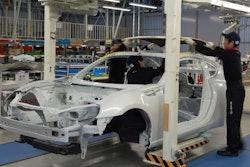It’s no surprise that IoT technology is estimated to be worth $6.2 trillion by 2025. Businesses and consumers alike are thrilled by the potential of IoT, therefore new IoT products are hitting the market every day. This puts manufacturers at the heart of the revolution. After all, manufacturers provide the digitally enabled machinery and equipment that allows companies to innovate with IoT. They are even spearheading innovative processes themselves, leveraging the digital capabilities of the equipment they use, ultimately creating smart factories.
Smart factories are the factories of the future, and will allow manufacturers to keep pace with the connected world and drive it forward. These factories leverage Industrial IoT (IIoT), big data, advanced analytics and new control systems to fuse automation and digitization to drive individualization of products through more efficient production methods. This new wave of smart manufacturing is ushering in what’s called Industry 4.0, which involves connecting smart machines, management systems, operating facilities and more, in a way that they can exchange information autonomously, trigger activities and collaborate seamlessly. It’s essential that manufacturers start preparing for and understanding the transitions to come, as smart factories become standard in the manufacturing industry.
Components of a Smart Factory: Connect, Integrate, Analyze
Digital technology on the shop floor and of the supply chain isn’t new. What is new is the way these technologies intelligently connect to the rest of the business and are able to deal with rapid change. Plenty of machines are already brimming with sensors, but still function autonomously. Industry 4.0 is all about connecting these sensors and making use of IIoT so that they collaborate. For example, a machine could sense that a drill bit is wearing out and automatically order a new one, alert the technical service department, and forward the purchase request to the ERP system. This improves efficiency and reduces the need for an employee to take these steps.
Software integration is an important factor for taking advantage of IIoT within a smart factory. Some software integration is happening at the solution provider level. For example, warehouse robots integrated into a Cloud platform are helping manufacturers evaluate predictive maintenance scenarios and monitor factory floors, driving closer integration of the top floor and shop floor. When software is integrated, all the data collected within the factory and supply chain can be aggregated and analyzed in real-time. This generates comprehensive reports on production status, machine maintenance, energy consumption and more, all of which can be used to optimize processes.
When it comes to asset management, this level of data analysis can help manufacturers stay competitive by assuring uptime and reducing wasted resources that drive-up maintenance costs. By integrating asset management systems, manufacturers can actually increase asset returns by 17 percent.
A New Way of Business for Manufacturers
Smart factories don’t only reduce costs, but also provide new opportunities for revenue by focusing on customer-centric processes. These factories have configurable systems, allowing for more flexible production. Manufacturers can serve the “segment of one,” meaning they can capture customer requirements effectively to drive mass customization. This type of flexible production will open the door to a new era of personalization.
Additionally, manufacturers can focus on differentiating products using digital capabilities like self-awareness of technical health and operational status. Having the ability to create such products makes manufacturers more attractive to the market. This also opens the door to extending the relationship with customers past the sale of the physical products.
The Employee’s Place in a Smart Factory
Using the insights from constant real-time data analysis available in smart factories, manufacturers can optimize autonomous production methods across the entire production chain and resources can be redistributed as necessary. This is particularly evident when it comes to employees. Smart factories reduce the need for employees to assist in optimizing processes and machine maintenance. However, this isn’t to say that there is no need for human employees in smart factories. In fact, Industry 4.0 brings positive changes to the workforce. For starters, there is increased transparency and access to data, which empowers the digital workforce and enables industrial professionals to tackle problems with confidence. Additionally, robot interactions change the role of the worker into more of an orchestrator and manager rather than a manual laborer.
Organizations can also mitigate health and safety risks by performing more thorough risk assessments, measuring emissions and implementing more effective controls. These types of assessments and changes are easy to implement with the right data and software in place. This will require IT to play a more central role in factories in order to maintain systems and software. IT will also be relied on for cybersecurity protection. With connected devices and machines, security is a major focus for smart factories.
Smart factories are the way of the future for manufacturers, and the future isn’t that far off. As machinery and software providers continue to work together, there will be easier integration across the manufacturing industry. The benefits of Industry 4.0 for manufacturers are clear, but the benefits for consumers are only starting to be realized. What lies ahead could be a world full of mass personalization and improved product services for everyone.
Stefan Krauss is General Manager of Discrete Manufacturing Industries at SAP.






















